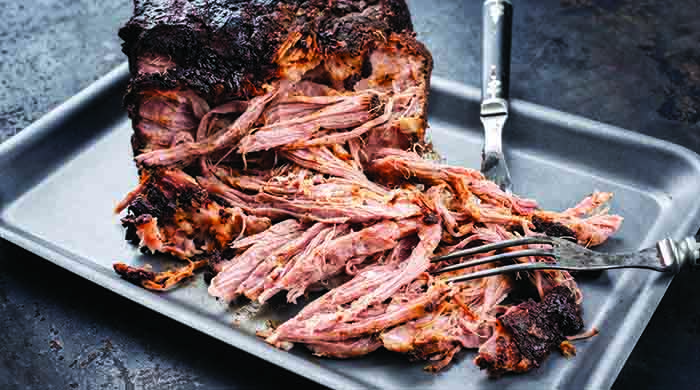How AHDB aims to bring pork dishes to whole new audience with an updated range of cuts
It may be surprising, and also exciting, to learn that there are now more than 150 different pork cuts, or variations, that give chefs and retailers options to include in pork dishes and products. And that’s not counting the offal products, which are important for foreign markets.

AHDB has expanded its meat product development work to include pork, led by senior business development manager Dick van Leeuwen, who has created a range of unique new pork cuts. This project is now fully under way and will help the pork sector keep pace with changes in consumer demands and provide the right cuts to compete with other meats for a range of meal occasions.
A Boston butt joint, oysters of pork or Presa steaks certainly sound like they could have a place on a menu in an up-and- coming restaurant or new retail product line. These are just a sample of the exciting, versatile pork products now available to both catering and retail businesses. It’s long overdue for the industry and will be welcomed by farmers and the supply chain.
NEW MEAT PURCHASING GUIDE
The up-to-date range of pork cuts is being added to the 2019 edition of AHDB’s Meat Purchasing Guide, designed for chefs, retailers, processors and exporters.
Mr van Leeuwen said: “It will have some new specifications for beef, veal, lamb, mutton and a completely new range of pork cuts. It includes codes for each cut and there is an accompanying step-by-step specification for each cut.
“These guides, and our soon-to-be- launched online pork Meat Education Programme, help provide greater integrity and consistency for red meat products in a challenging marketplace, which has changed tremendously to meet more discerning consumer demands.”
Proactive development work has a key role in prompting the next ‘big thing’ in restaurants and retailers, which needs long- term, continuous investment and innovation.
Availability of new and innovative pork cuts helps ignite greater demand for UK pork products, both at home and in foreign markets. Plus, it often contributes to higher overall carcase value by taking a lower-value primal cut and finding another way to cut and cook it.
Lamb shank was a good example of this 15 years ago. It used to be seen as too expensive a cut, but AHDB suggested to chefs that it would be ideal for a pub menu and could be cooked sous vide (slowly in a plastic bag), to create a tasty, succulent dish, commanding a higher price on the menu.
Working with top chefs on how to better use different cuts is often the starting point for Mr van Leeuwen’s development work. Therefore, a new cut often appears on foodservice menus first, before gaining in popularity and then being picked up and used in retail products. Chefs like to be able to offer something new to diners to maintain a competitive edge. The Meat Purchasing Guide is a unique and comprehensive source of inspiration for this. Mr van Leeuwen said: “It’s about adding additional value and then maintaining the market for that cut beyond the initial trend. The product needs to be appealing to the consumer and meet a particular need.”
High-profile chefs can also be very effective at creating demand – with Jamie Oliver’s promotion of belly pork being another example of how a low-value cut can become a regular on restaurant menus – but the industry can’t rely only on this type of occasional boost.

CHALLENGING CHICKEN’S DOMINANCE IN READY MEALS
AHDB’s guides contain a number of pork dice and stir-fry cuts, some of which are well-suited for use in ready meals, helping pork compete with chicken. There are around 30 different cuts of chicken used throughout a range of products and pork can easily deliver the same versatility.
Certain cuts are also as lean as chicken, where consumers are looking for healthier options.
There are also cuts that cater for other modern trends. For example, loin cannon, where the loin is cut in half lengthways, can be sliced into small discs – ideal for pan frying and individual portions.
MEAT EDUCATION PROGRAMME
Another key initiative is the free-to-use AHDB Meat Education Programme, which has already been incorporated into many of the large processing plants’ internal training programmes. The training links directly to the content in the Meat Purchasing and Cutting Guides and new pork training modules will also be ready this year for all parts of the trade.
Around 200 people per month take the online assessments for the beef and lamb training. Trainers can also download material for use in exam situations.
RECIPE INSPIRATION
A new website will be launched in the summer hosting all the training courses and materials for pork, beef and lamb, along with digital versions of both guides. This move will help widen access to information and provide recipe ideas alongside the step- by-step guide to each of the cuts.
Beef and lamb purchasing and cutting guides have been downloaded tens of thousands of times since they were first published in 2007. Globally, it’s probably the only publication of its kind that provides detailed cutting specifications for such a wide range of cuts.
They’re now being used in French catering colleges, which helps UK beef and lamb exporters by driving demand for a widening range of cuts, making best use of and adding value to as much of the carcase as possible.
Every cut is coded, so that if someone wants more detail on a cut they’ve spotted in the purchasing guide, they can quickly find it in the cutting guide.
Mr van Leeuwen’s role also includes providing advice on which cuts to use and how best to cook them both in foodservice and for retailers and, where needed, giving specific support beyond what’s widely available in the guides and educational materials.
While it can take a long time for new products to be developed, taken up and established in the market, adding new ideas into the pipeline helps provide the bedrock for AHDB’s other key market development programmes, including the Pulled Pork and Midweek Meal campaigns in the UK and opening up more export opportunities.
Look out for more on pork product development at Pigs Tomorrow on May 14 and 15 and visit the current meat education programme website at: www.qsmbeefandlamb.co.uk/mep-signin.




